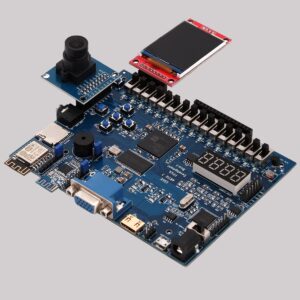Digital Safe System(using sequential circuit)
In improved the digital safe system.
The user will have chance to enter his or her password instead of
a fixed initial
value.
This module has five inputs.
·
clk (main
clock signal),
·
passinput (16-bit
password)
·
pass_set (input
to change password),
·
pass_reg (input
to save new password)
·
pass_lock (to
lock safe again after the password change).
The output of the module is a two-bit vector safestate.
This output indicates the state of lock, such that
00 shows locked;
01 indicates open;
10 represents enter new
password;
11 shows new password set.
Working principles of digital safe module (as a state machine) are
as follows. The state machine has two states: ENTERPASS and SETPASS.
In ENTERPASS state,
the machine checks whether the input matches the password.
If this is the case, safestate changes
to 01 which shows that lock is open. Besides, if pass_set is at logic level 1, then state of the machine goes to SETPASS where
the new password is entered. After the user determines a new password, pass_reg should
go to logic level 1 to save it. Then, pass_lock should go to logic level 1 to lock the
safe again.
We provide the modified Verilog description for the digital safe
module
in CODE-1.
********************************************************************************
CODE-1
module
digital_safe2(clk,passinput,pass_set,pass_reg,pass_lock,safestate);
input clk;
input
[15:0] passinput;
input
pass_set,pass_reg,pass_lock;
output
reg [1:0] safestate;
//00:locked(c),
01:open(o), 10:enterpass, 11:pass changed(s)
localparam ENTERPASS=1'b0,SETPASS=1'b1;
reg
[1:0] state=ENTERPASS;
reg
[15:0] pass=16'h1234;
always
@ (posedge clk)
case(state)
ENTERPASS:
if
(passinput == pass && pass_set == 1'b1)
begin
state <= SETPASS;
safestate <= 2'b10;
end
else
if (passinput == pass)
safestate <= 2'b01;
else
safestate <= 2'b00;
SETPASS:
if
(pass_reg == 1'b1)
begin
pass <= passinput;
safestate <= 2'b11; end
else
if (pass_lock == 1'b1)
state <= ENTERPASS;
endcase
endmodule
********************************************************************************
We can further improve the
digital safe system to be implemented on the
FPGA board.
Here, we can show state of the lock and the new password on the
seven-segment display. To do so, we should add the seven-segment display module
as an IP block.
Inputs of the digital safe module will be connected to buttons and
switches on the FPGA board. Hence, we should also add the debounce module as an
IP block.
In CODE-2 pass_set, pass_reg, and pass_lock inputs are assigned to btnU, btnD, and btnC of the Basys3 board
respectively. Sixteen switches are used as passinput. The master clock of the board is connected to clk signal.
The output safestate
of the digital safe module is kept in a vector with the same name
to control the seven-segment display on the board. Hence, when safestate
is at 00 all four seven-segment display digits will show character
C which stands for “Close”. When safestate is
at 01, all display digits will show the character O which
stands for “Open”. When safestate is at 11, all digits will show the character S which
stands for “Set”. In the 01 state (referring to the password change), digits
show the password while the user changes it.
We provide the top module for this application in CODE-2
.
********************************************************************************
CODE-2
module digital_safe_topmodule(clk,sw,btnC,btnU,btnD,led,an,seg);
input clk;
input [15:0] sw;
input btnC,btnU,btnD;
output [1:0] led;
output [3:0] an;
output [6:0] seg;
wire btnCclr,btnDclr,btnUclr;
debounce_0
dbc(clk,btnC,btnCclr);
debounce_0
dbu(clk,btnU,btnUclr);
debounce_0
dbd(clk,btnD,btnDclr);
reg [3:0] disp1=4'b0;
reg [3:0] disp2=4'b0;
reg [3:0] disp3=4'b0;
reg [3:0] disp4=4'b0;
sevenseg_driver_0
seg7(clk,1'b0,disp1,disp2,disp3,disp4,seg,an);
wire [1:0] safestate;
digital_safe2_0
ds(.clk(clk),.passinput(sw),.pass_set(btnUclr),.pass_reg(btnDclr),.pass_lock(btnCclr),.safestate(safestate));
always @ (posedge clk)
case(safestate)
2'b00 :
{disp1,disp2,disp3,disp4} <= {4{4'b1100}}; //C
2'b01 :
{disp1,disp2,disp3,disp4} <= {4{4'b0000}}; //0
2'b10 :
{disp1,disp2,disp3,disp4} <= sw;
2'b11 :
{disp1,disp2,disp3,disp4} <= {4{4'b0101}}; //S
endcase
assign led = safestate;
endmodule
********************************************************************************
Digital Safe System(FINAL MODULE)
We can finalize the digital safe system by adding a USB keyboard
to it.Besides, the digital safe will work as explained in CODE
1 &2. We provide the modified and final form of the digital safe in CODE-3.
Let’s
explain the working principles of the digital safe system (as a state machine)
step by step. The system starts with a default password 1234. When the user
enters it, the safe opens. Here, user has two options. The first one is
changing the password. The second one is locking the safe again. When btnC on the Basys3
board is pressed, the safe locks again. If the user presses btnU, digital safe
goes to the password changing state. Here, it expects the user to enter a new
password. This can be done by using numbers on the keyboard. Since this is a
prototype system, the entered password is also shown on the seven-segment
display (and LEDs) of Basys3.When a new password is entered, the user should
press btnD
to
save it. Afterward, btnC
should
be pressed to lock the safe again. While entering the password digits, the user
may press btnR
anytime
to restart again.
********************************************************************************
CODE-3
module
digital_safe_topmodule(clk,btnU,btnC,btnD,btnR,PS2Data,PS2Clk,seg,an,led);
input clk;
input
btnC,btnU,btnD,btnR;
input PS2Data;
input PS2Clk;
output [3:0] an;
output [6:0] seg;
output [15:0] led;
wire
btnCclr,btnDclr,btnUclr,btnRclr;
debounce_0
dbc(clk,btnC,btnCclr);
debounce_0
dbu(clk,btnU,btnUclr);
debounce_0
dbd(clk,btnD,btnDclr);
debounce_0
dbr(clk,btnR,btnRclr);
reg [3:0] disp1;
reg [3:0] disp2;
reg [3:0] disp3;
reg [3:0] disp4;
sevenseg_driver_0
seg7(clk,1'b0,disp1,disp2,disp3,disp4,seg,an);
wire [1:0] safestate;
reg [15:0] password;
digital_safe2_0
safe1(.clk(clk),.passinput(password),.pass_set(btnUclr),.pass_reg(btnDclr),.pass_lock(btnCclr),.safestate(safestate));
wire keyready;
reg keyready_prev;
reg [1:0] keystate=0;
wire [7:0] keyout;
keypad_app_0
key1(.clk(clk),.PS2Clk(PS2Clk),.PS2Data(PS2Data),.keyout(keyout),.ready(keyready));
always @ (posedge
clk)
begin
keyready_prev <=
keyready;
if (btnRclr) keystate
<= 2'b0;
else if (btnCclr ==
1'b1) password <= 16'b0;
else
case (keystate)
2'b00:
if (keyready_prev == 0 &&
keyready == 1) begin
password[15:12] <= keyout;
keystate <= keystate + 1'b1;
end
2'b01:
if (keyready_prev == 0 &&
keyready == 1) begin
password[11:8] <= keyout;
keystate <= keystate + 1'b1;
end
2'b10:
if (keyready_prev == 0 &&
keyready == 1) begin
password[7:4] <= keyout;
keystate <= keystate + 1'b1;
end
2'b11:
if (keyready_prev == 0 &&
keyready == 1) begin
password[3:0] <= keyout;
keystate <= 2'b00;
end
endcase
end
always @ (posedge
clk)
case(safestate)
2'b00: {disp1,disp2,disp3,disp4} <=
{4{4'b1100}}; //C
2'b01: {disp1,disp2,disp3,disp4} <=
{4{4'b0000}}; //0
2'b10: {disp1,disp2,disp3,disp4} <=
password;
2'b11: {disp1,disp2,disp3,disp4} <=
{4{4'b0101}}; //S
endcase
assign led =
password;
endmodule
********************************************************************************



